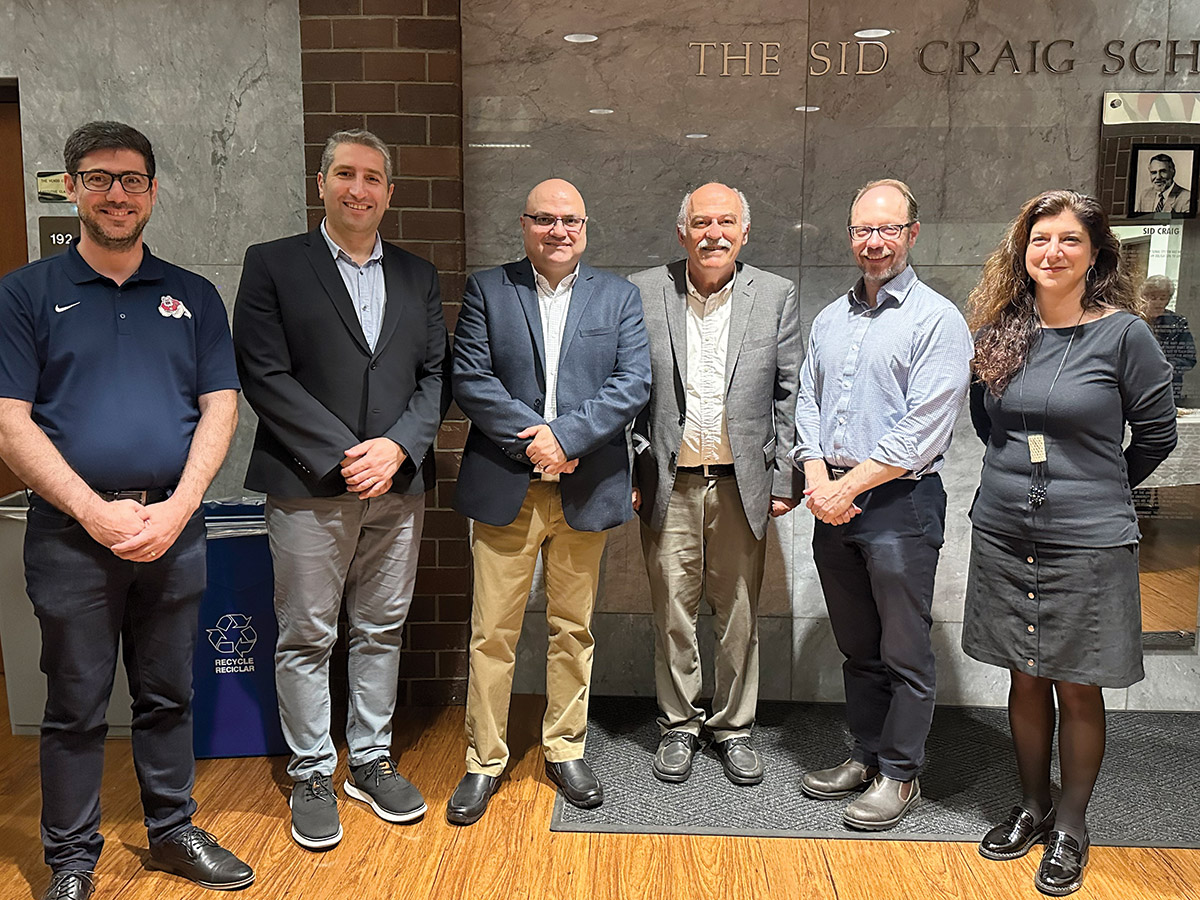
Photo: Natalie Agazarian
Careen Derkalousdian
Staff Writer
“As much as the Internet is developing,” said Dr. Bedross Der Matossian, “denial is developing with it.”
On Friday, April 11, 2025, Dr. Der Matossian presented a lecture on “Denial of the Armenian Genocide in the Digital Age: Re-fashioning the ‘Events of 1915’ on the Internet and Beyond.”
Dr. Der Matossian is a Professor of Modern Middle East History and the Hymen Rosenberg Professor in Judaic Studies at the University of Nebraska, Lincoln. His presentation was part of the Spring Lecture series of the Armenian Studies Program and was supported by the Florence Elaine Hamparson Armenian Memorial Fund.
Dr. Der Matossian began his lecture by stating that the internet is a double-edged sword. While it has the potential to educate the public, it can also serve a more sinister purpose – to disseminate hatred, bigotry, and denial of genocides.
In defining denial, Dr. Der Matossian stated that “Denial is not only the reluctance to acknowledge the historical injustices of the past, but it further aims at killing the dead and their memory over and over, inflicting pain on the survivors and their descendants, and demonstrating that future acts of violence are possible in a climate of deception and impunity.”
Common arguments used by Armenian Genocide denialists include questioning the concept of genocide, debating evidence, denying attacks on victims, practicing nationalist hubris, and attributing the death toll to natural factors or attacks by Kurdish tribes.
Before the “Digital Age,” denial encompassed the production of print and audiovisual propaganda, the desecration of genocide monuments, and the exertion of pressure on governments to avoid using the word genocide. The first denialist publication dates to 1916 and is titled Ermeni Komitelerinin Âmâl ve Harekât-ı İhtilâliyesi: İlân-ı Meşrutiyetden Evvel ve Sonra (The Armenian Revolutionary Aspirations and Movements: Before and After Proclamation of the Constitution). This fraudulent book contains 300 images, including photos of Turks posing with a considerable number of weapons which they falsely claimed belonged to Armenians. Dr. Der Matossian explained that these weapons were often collected to promote the propaganda that Armenians were planning a major uprising against the Ottoman empire.
Another notorious case of denial was in 1934, when Franz Werfel’s masterpiece novel, The Forty Days of Musa Dagh, was on its way to being produced by Metro-Goldwyn-Mayer (MGM), a major Hollywood film studio, when production was brought to a screeching halt by the Turkish government. Dr. Der Matossian pointed out the true weight of this incident by noting that the Armenian Genocide was covered daily in newspapers and actively discussed at major universities during that time. This demonstrates the raw power of denial, which can mask even the most apparent and evidential truths.
Now in the “Digital Age,” with more weapons of denial in their arsenal, the Turkish government and non-state actors may post, comment, and publish digitally, allowing them to share their denialist propaganda across a broader audience.
The year 1989 marked the beginning of digital denial with the first manifestation of denying the Armenian Genocide in an online discussion forum. During his research, Dr. Der Matossian discovered several key novelties of internet-based denial, including the wide availability of classic denialist texts online, use of graphical and artistic approaches, anonymous entities running websites, and extension to social networks such as Instagram, X, and Facebook.
In a recently published article, Dr. Der Matossian classified denialist websites into three categories: official (government-run), non-official (organizations and associations), and anonymous. He argued that the most significant denialist website is that of the Ministry of Foreign Affairs of Turkey, which has a whole section titled the “Controversy between Türkiye and Armenia about the Events of 1915.” They cite denialist literature and relativize suffering, claiming that the Armenian Genocide was a war with casualties on both sides. Most appallingly, the website defends the “relocation” of Armenians as a safety measure to protect them from the so-called war zone. In reality, this euphemism refers to the mass deportations and death marches into the Syrian desert of Der es-Zor, to which Armenians were forcibly subjected by the Ottoman Turks. By using deceptive language, this website twists a horrific truth into a false narrative.
Two of the most popular non-governmental denialist websites are those sponsored by the Turkish Coalition of America (TCA) and the Assembly of Turkish American Associations (ATAA). Both websites refuse to use the word genocide and provide links to denialist literature. The most sophisticated anonymous website is Fact Check Armenia (FCA), which was launched in 2015, on the centennial of the Armenian Genocide. FCA’s high-quality videos disguise its bogus content as it uses a fact-checking format to spread misinformation and denial.
Denialists also prowl on social media. One of the most well-known denialists is Dr. Justin McCarthy, an American historian with extensive ties to Turkish institutions. He is often criticized by scholars and organizations for his denialist views and pro-Turkish bias, which he proudly shares on his Facebook account.
Dr. Der Matossian went on to discuss “The Promise,” a popular film about the Armenian Genocide. Before the movie’s release in the United States, the film received more than 50,000 1/10 ratings on the Internet Movie Database (IMDb) website. Stefan Ihrig, a Genocide scholar, remarked that “We are witnessing yet another anti-Armenian denialist campaign playing out abroad, far away from Turkey, in open, democratic societies…Few movies have ever experienced such a pre-release buzz on IMDb.” In response to “The Promise,” the Turkish government released a film called “The Ottoman Lieutenant,” which depicted the Genocide as unorganized killings rather than the planned atrocity that it was, further denying and minimizing the truth that is the Armenian Genocide.
Despite the ever-evolving denial tactics, there is still hope for Armenians. To combat genocide denial, Dr. Der Matossian encouraged people to expose and counter arguments academically, using digital tools to educate society about the dangers of denying historical atrocities.
 Hye Sharzhoom Armenian Action
Hye Sharzhoom Armenian Action